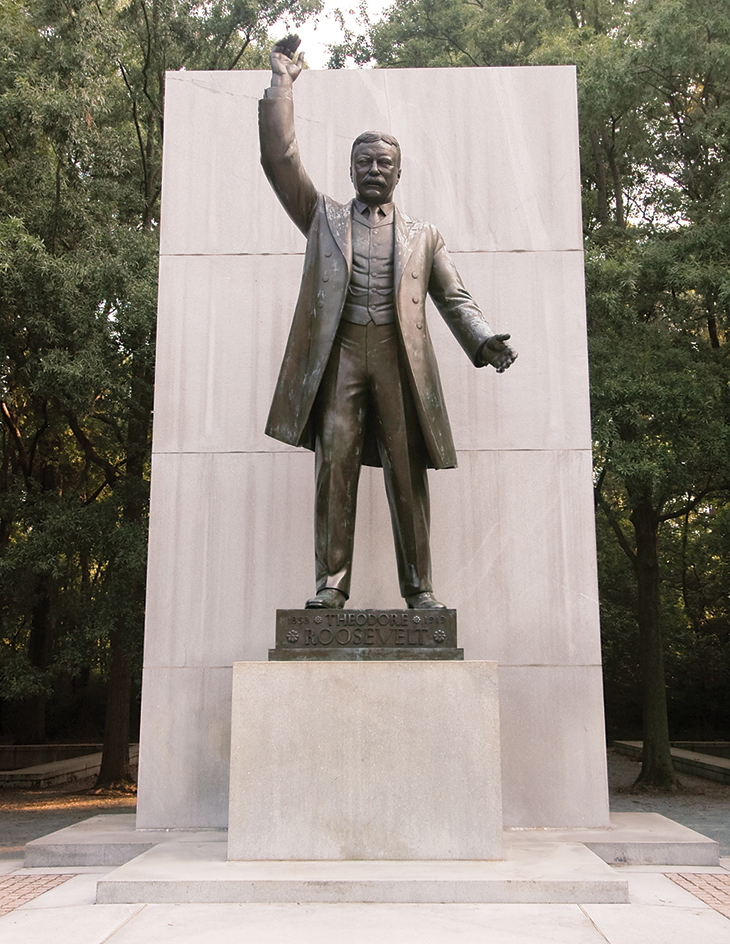Roosevelt << ROH zuh vehlt >>, Theodore (1858-1919), was the youngest man ever to become president of the United States. He took office at the age of 42. Roosevelt had been vice president for only six months when President William McKinley was assassinated in September 1901. Roosevelt won wide popularity, and millions of Americans affectionately called him “Teddy” or “T.R.” In 1904, the voters elected him to a full term as president. He ran for president again in 1912, as the “Bull Moose” party candidate, but lost to Woodrow Wilson.
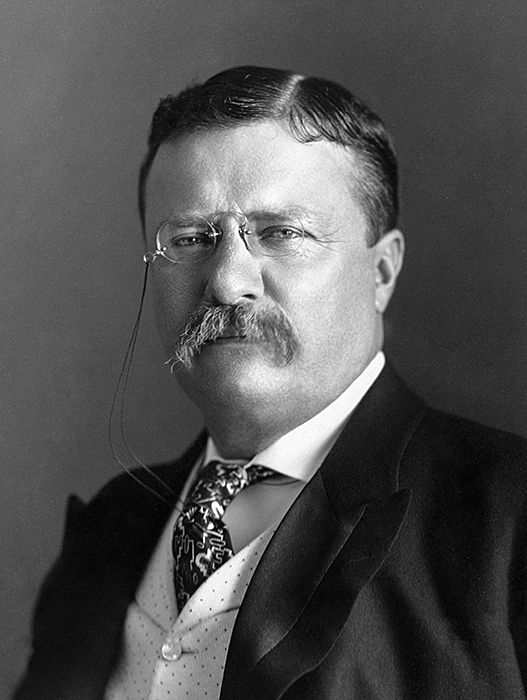
Roosevelt was a man of great energy and practiced what he called the “strenuous life.” He enjoyed horseback riding, swimming, hunting, hiking, and boxing. He often expressed enthusiasm for something by describing it as “bully.” Cartoonists liked to draw Roosevelt with his rimless glasses, bushy mustache, prominent teeth, and jutting jaw. One cartoon showed him with a bear cub. Soon, toymakers were producing stuffed animals that are still known as “teddy bears.”
As commander of the fearless Rough Riders, Roosevelt became a national hero during the Spanish-American War in 1898. He led this famous cavalry regiment against the Spaniards in Cuba. Roosevelt came home and won election as governor of New York. Two years later, he was elected vice president.
As president, Roosevelt used his power of leadership to help the United States meet challenges at home and abroad. “I did not usurp power,” Roosevelt said, “but I did greatly broaden the use of executive power.”
Roosevelt fought for reforms that would benefit the American people. He became known as a “trust buster” because he tried to limit the power of great business corporations. During his administration, Congress passed laws to regulate the railroads, to protect the public from harmful foods and drugs, and to conserve the nation’s forests and other natural resources.
In foreign relations, Roosevelt worked to make the United States a world leader. He felt that this leadership must be supported by strong armed forces. He expressed his foreign policy as: “Speak softly and carry a big stick.” Roosevelt strengthened the U.S. Navy, began the construction of the Panama Canal, and kept European nations from interfering in Latin America. He helped end the Russo-Japanese War, and became the first American to receive the Nobel Peace Prize.
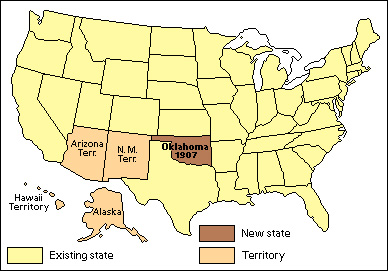
While Roosevelt was president, millions of Americans traveled by bicycle—even women in their sweeping, ankle-length skirts. But automobiles, along with electric lights and telephones, started to come into widespread use. Guglielmo Marconi and his staff sent and received the first radio message across the Atlantic Ocean, and a telegraph cable was laid across the Pacific to the Philippines. The air age was born when the Wright brothers flew the first successful airplane. Roosevelt enjoyed taking a ride in one of the early models.
Roosevelt regarded public life as a great stage. As president, he joyfully held the center of that stage. When Roosevelt left office, he wrote: “I do not believe that anyone else has ever enjoyed the White House as much as I have.” He was probably right.
Early life
Boyhood and education.
Theodore Roosevelt was born in New York City on Oct. 27, 1858. He was the second of the four children of Theodore and Martha Bulloch Roosevelt. “Teedie,” as the family called him, was younger than his sister Anna, and older than his brother Elliott and his sister Corinne.
Roosevelt’s ancestors, the Van Roosevelts, had come to America from Holland in the 1640’s. One of these ancestors, Klaes Martensen Van Roosevelt, settled in New York, which was then called New Amsterdam. Klaes was also an ancestor of Franklin D. Roosevelt, the 32nd president of the United States. Most of the Van Roosevelts were wealthy landowners and business leaders.
Theodore Roosevelt’s mother came from a prominent Georgia family. One of her brothers was an admiral in the Confederate Navy. She sympathized with the South during the Civil War. Her husband, an importer of plate glass, supported the North. But the Roosevelts did not let their differences keep them from providing a happy home life for their family.
Like his father, Teedie had great energy, curiosity, and determination. He enjoyed an active childhood although he was puny and frequently ill. He suffered greatly from asthma. While playing with friends one day, he discovered that he also was nearsighted. The other children easily read an advertisement on a billboard some distance away. “Not only was I unable to read the sign, but I could not even see the letters,” Roosevelt wrote later. From then on Theodore wore glasses.
Theodore loved both books and the outdoors. He combined these interests in nature study. His bureau drawers smelled of dead mice and birds, and so, often, did Theodore. When he was 10, and again when he was 14, Theodore went with his family on yearlong trips abroad. He visited Europe and the Middle East.
When Theodore was about 12, his father told him that he would need a strong body to give his mind a chance to develop fully. The next year, while alone on a trip to Maine, Theodore was tormented by two mischievous boys. He felt ashamed because he was not strong enough to fight back. Roosevelt’s father built a gymnasium in the family home, and Theodore exercised there regularly. He overcame his asthma and built up unusual physical strength.
Roosevelt studied under tutors until he entered Harvard University in 1876 at the age of 18. He earned good grades in college. Once he asked so many questions during a lecture that the professor exclaimed: “Now look here, Roosevelt, let me talk. I’m running this course!” Roosevelt graduated from Harvard in 1880.
First marriage.
In October 1879, Roosevelt met Alice Hathaway Lee (1861-1884). She was the daughter of a wealthy official of a Boston investment firm. Roosevelt courted Alice during his senior year at Harvard. They were married on his 22nd birthday.
A double tragedy struck on Feb. 14, 1884. Alice Roosevelt died two days after the birth of a daughter, also named Alice (1884-1980). On the same day, Roosevelt’s mother died of typhoid fever.
Political and public activities
State legislator.
After graduation from Harvard in 1880, Roosevelt did not know what to do for a living. His father, who had died in 1878, had left him some money. But Theodore needed to earn more in order to live comfortably. He enrolled in the Columbia University Law School, but the courses did not interest him. While studying law, he wrote The Naval War of 1812, a technically excellent but dull book.
Roosevelt decided to enter politics as a means of public service. He joined a Republican club in New York City. He recalled that his friends “laughed at me, and told me that politics were ‘low …’ I answered that … the people I knew did not belong to the governing class, and that the other people did—and that I intended to be one of the governing class.”
In the fall of 1881, at the age of 23, Roosevelt won election to the New York State Assembly. He wore sideburns and dressed elegantly. The other legislators thought he looked like a “dude.” But his intelligence, courage, and energy won their respect. He was reelected twice, in 1882 and 1883.
Party leader.
In 1882, Roosevelt served briefly as leader of the Republican minority in the Assembly. State party bosses expected him to follow orders, but he refused to obey blindly. The bosses removed him as minority leader. However, Roosevelt remained the most influential man in the Assembly. He worked closely with Governor Grover Cleveland, a Democrat, and became interested in civil service reform.
Rancher and writer.
After the death of his wife and mother in 1884, Roosevelt left politics. He ran two cattle ranches on the Little Missouri River in the Dakota Territory. The hard life and endless activity of a rancher helped him recover from his sorrow. Wearing cowboy clothes, Roosevelt often spent 14 to 16 hours a day in the saddle. He hunted buffalo and other wild animals, tended cattle, and even helped law officers capture a band of outlaws. 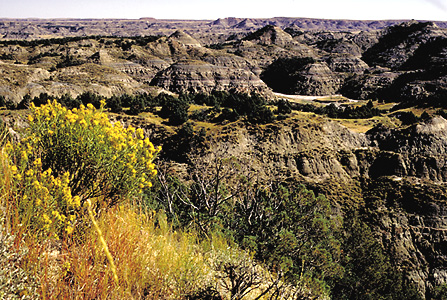
Roosevelt wrote steadily. In one period of less than three months, he completed a biography of Senator Thomas Hart Benton of Missouri. Roosevelt also wrote a four-volume series called The Winning of the West.
Severe snowstorms in the winter of 1885-1886 destroyed most of Roosevelt’s cattle. He returned to New York City in 1886 and at the request of Republican leaders, ran for mayor. He was badly defeated.
Second marriage.
During several trips home from his ranches, Roosevelt had visited a childhood friend, Edith Kermit Carow (1861-1948). They were married on Dec. 2, 1886, and lived in Sagamore Hill, Roosevelt’s home in Oyster Bay, Long Island, New York. Edith Roosevelt had a strong influence on her husband. He came to depend on her advice. “Whenever I go against her judgment, I regret it,” he said. 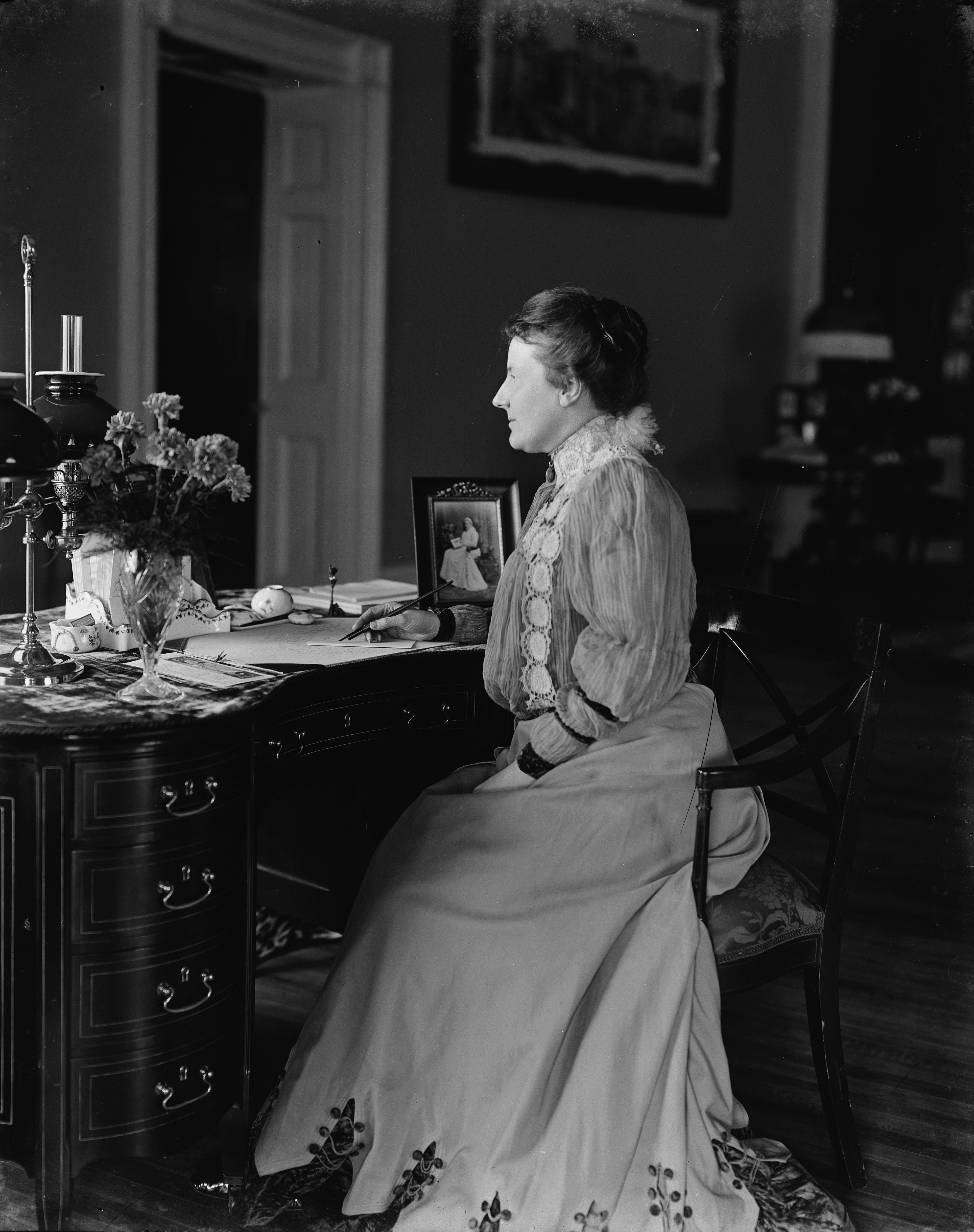
The Roosevelts had five children: Theodore, Jr. (1887-1944); Kermit (1889-1943); Ethel Carow (1891-1977); Archibald Bulloch (1894-1979); and Quentin (1897-1918). Mrs. Roosevelt reared Alice Roosevelt, Theodore’s daughter by his first wife, as her own child. Roosevelt loved to play with his children.
Civil Service commissioner.
Benjamin Harrison won the Republican nomination for president in 1888. Roosevelt went on a speaking tour for Harrison, who was elected in November. Partly as a reward for Roosevelt’s service, Harrison appointed him to the Civil Service Commission. Roosevelt brought publicity to the commission, which previously had attracted little attention. He improved the merit system by establishing examinations for some Civil Service jobs. He opposed the awarding of government jobs to political friends. Many Republicans resented his attitude. But President Grover Cleveland reappointed him in 1893.
Police commissioner.
In 1895, Roosevelt gladly accepted the post of president of the Board of Police Commissioners in New York City. For the next two years, he fought to stamp out dishonesty on the police force. Sometimes he patrolled the streets at night to check on police officers suspected of illegal activities.
A national figure
Assistant secretary of the Navy.
In 1895, some friends asked Roosevelt if he might be a candidate for president. “Don’t you dare ask me that!” Roosevelt exclaimed. “Don’t you put such ideas into my head . … I must be wanting to be president. Every young man does. But I won’t let myself think of it … because if I do, I will begin to work for it, I’ll be careful, calculating, cautious… and so—I’ll beat myself. See?”
Roosevelt campaigned vigorously for William McKinley, the Republican candidate for president in 1896. McKinley won, and Roosevelt asked him for a government appointment. McKinley did not want this brash young man in Washington, but Roosevelt had powerful support. The president finally made him an assistant secretary of the Navy.
Roosevelt believed that sea power was the decisive factor in world history. He worked to strengthen the Navy. He also believed that war for a righteous cause brought out the finest virtues in people and nations. “No triumph of peace is quite so great as the supreme triumphs of war,” he said soon after taking office. “The diplomat is the servant, not the master, of the soldier.”
The Rough Riders.
Since 1895, Cuban rebels had been revolting against their Spanish rulers. Many Americans demanded that the United States help the Cubans. On Feb. 15, 1898, the U.S. battleship Maine blew up in Havana harbor. Roosevelt tried to rush preparations for war against Spain. He became impatient with McKinley’s attempts to avoid war. In private, Roosevelt complained that the president had “no more backbone than a chocolate eclair.”
On April 25, 1898, the United States declared war on Spain. Roosevelt immediately resigned as assistant secretary of the Navy so he could fight. Even before resigning, he had started to recruit men for a cavalry regiment. This unit became the First Volunteer Cavalry Regiment. Under Roosevelt’s command, it won fame as the Rough Riders. Most of the men were former college athletes and Western cowboys. 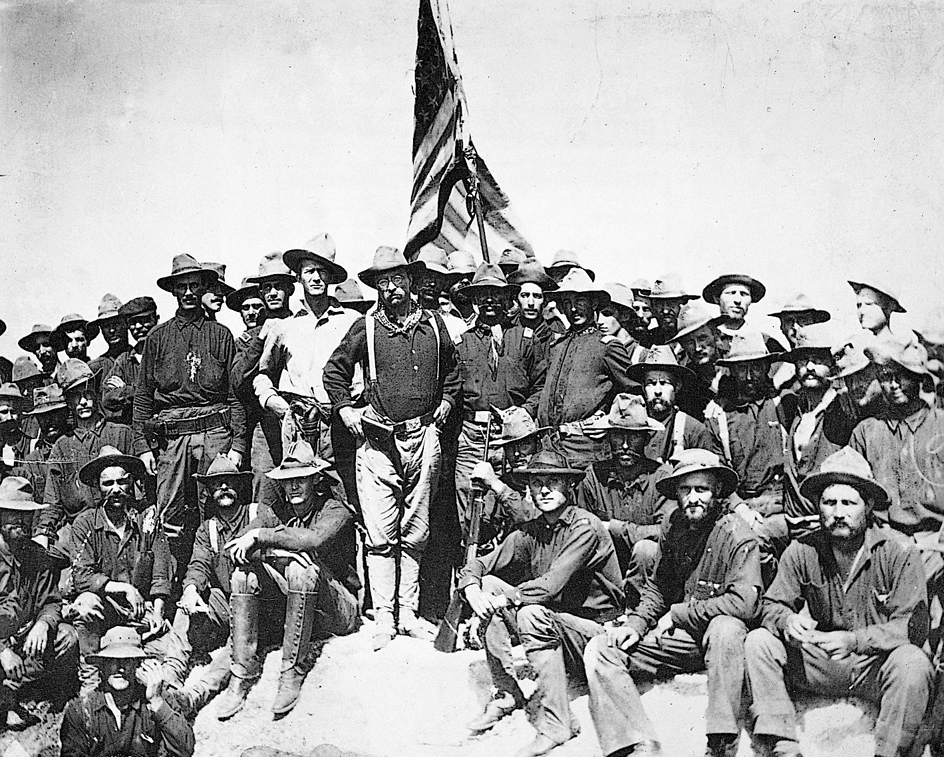
On July 1, 1898, American troops attacked a ring of fortified hills surrounding Santiago, Cuba. Colonel Roosevelt led his men in a charge up Kettle Hill, which flanked the Spanish blockhouse on San Juan Hill. He and the Rough Riders became nationally famous. Twenty years later he declared: “San Juan was the great day of my life.”
Governor of New York.
The Republicans faced defeat in New York in 1898 because of a scandal over state canal contracts. The state party leader, Senator Thomas C. Platt, did not like Roosevelt. But Platt knew that Roosevelt’s reputation might save the Republicans. Roosevelt agreed to run for governor. He won, largely because of his war record.
As governor, Roosevelt did not break with Platt. Neither did he follow Platt’s wishes. He described this policy to a friend: “I have always been fond of the West African proverb: ‘Speak softly and carry a big stick, you will go far.’ ” Roosevelt became an efficient, independent administrator. He supported mild reform legislation, including a law affecting civil service in the state. He angered large business interests by approving a bill for the taxation of corporation franchises.
Vice president.
McKinley’s renomination in 1900 seemed certain. Roosevelt had no wish to oppose the president, who he knew had nationwide support. But Roosevelt wondered whether he himself might get the nomination in 1904. As the Republican National Convention drew near, a movement began to nominate him for vice president.
Roosevelt felt that being vice president would take him out of active politics. In this way, his chances for the presidential nomination in 1904 would be weakened. Roosevelt also knew that Senator Platt wanted to get rid of him as governor of New York. Roosevelt felt he might not win a second term as governor in opposition to Platt. He finally consented to be McKinley’s running mate. The Republicans nominated both men by acclamation. In the election, McKinley and Roosevelt defeated their Democratic opponents, William Jennings Bryan and former Vice President Adlai E. Stevenson.
On Sept. 6, 1901, only six months after his second inauguration, President McKinley was shot by an assassin. The tragedy occurred while McKinley was at the Pan American Exposition in Buffalo, New York. Doctors told Roosevelt that McKinley would probably recover. But, while vacationing in the Adirondack Mountains, Roosevelt learned McKinley was near death. He hurried to Buffalo, but McKinley died before Roosevelt arrived. That same day, Sept. 14, 1901, Roosevelt took the oath of office as president. See McKinley, William (Assassination).
Roosevelt’s first administration (1901-1905)
Roosevelt became president just six weeks before his 43rd birthday. He kept all the members of McKinley’s Cabinet. He said he would continue McKinley’s policies “absolutely unbroken.” But Roosevelt had too much originality to follow another person’s plans.
Most business leaders feared Roosevelt because of some reforms he had introduced as governor of New York. Several of these reforms had brought about stricter government control over industry. Early in his administration, Roosevelt tried to convince business people that he would not interfere with them. He also tried to persuade conservative Republican leaders that he was not dangerous. But he never won them over completely. They considered much of his legislation dangerously progressive, even socialistic. The Republicans controlled Congress throughout Roosevelt’s presidency. But because of conservative opposition, Roosevelt had increasing difficulty getting Congress to act on his recommendations.
“Trust buster.”
Many Americans had become worried about the trusts, or large business monopolies. These trusts were increasing rapidly in both number and power. The trusts had increased productivity and had raised the standard of living. But prices had also risen, and the people blamed the trusts. In his first message to Congress, in December 1901, Roosevelt expressed this feeling. “Captains of industry … have on the whole done great good to our people,” he said. But he also pointed to “real and grave evils.” Roosevelt recommended that “combination and concentration should be, not prohibited, but supervised and, within reasonable limits, controlled.”
In 1902, the government sued the Northern Securities Company on charges of trying to reduce competition. This firm had been formed by J. P. Morgan and other financiers to control key railroads in the West. Roosevelt said he did not want to use the power of the government to ruin Morgan. Rather, he wanted to keep order among all the great economic forces in the nation. The Supreme Court upheld the government’s view in 1904. It dissolved the Northern Securities Company.
During Roosevelt’s presidency, the government filed suits against 43 other corporations. In major cases, the government ended John D. Rockefeller‘s oil trust and James B. Duke‘s tobacco trust. Many people called Roosevelt a “trust buster.” But the president declared that he wanted the government to regulate, not “bust,” trusts.
Friend of labor.
Roosevelt wanted the government to act justly toward labor unions as well as toward business. Government intervention in labor disputes was not new. But it had usually favored management.
In May 1902, about 140,000 members of the United Mine Workers went on strike in the hard-coal fields of Pennsylvania. Public opinion favored the strikers, who demanded more pay and better working conditions. As the strike continued, coal supplies began to run low in Eastern cities. Many hospitals and schools had no fuel. Winter was approaching.
Roosevelt had no legal authority to intervene in the strike. But he called a conference of leaders of both sides. He proposed that the strike be settled by arbitration. The miners agreed, but the mine owners refused. Roosevelt threatened to have the army seize and operate the mines. At Roosevelt’s request, J. P. Morgan helped reach a compromise with the mine owners. The miners got a pay raise the next March. Roosevelt said later that he had tried to give the miners a “square deal.” He often used this phrase to refer to his policy of social reform. In 1903, Congress established the Department of Commerce and Labor (see Labor, Department of).
Foreign policy.
Roosevelt believed that the government needed a “big stick,” or threat of force, to carry out its foreign policies. He used this policy in relations with Europe and Latin America.
The Venezuela Affair.
The Monroe Doctrine held that the United States should keep European powers out of the Western Hemisphere. Roosevelt upheld this doctrine in what was known as the Venezuela Affair.
Venezuela had borrowed large sums of money in Europe. In December 1902, British, German, and Italian ships blockaded Venezuelan ports to force payment of the debts. Roosevelt feared that Germany planned to seize Venezuelan territory. He warned the Germans that he might have to use force if they took any part of Venezuela. The Germans withdrew their warships. Later, Roosevelt helped settle the dispute peacefully.
The “Roosevelt Corollary.”
In 1904, the Dominican Republic found it could not pay its debts to several European countries. Again, Roosevelt feared European intervention. He announced that the United States might be forced “in flagrant cases of … wrongdoing or impotence, to the exercise of an international police power.” This policy was called the “Roosevelt Corollary” of the Monroe Doctrine.
Roosevelt ordered American officials to take over the customs system of the Dominican Republic in 1904. American control, which began the next year, brought order to the Dominican Republic’s finances.
The Panama Canal.
Between 1902 and 1905, Roosevelt persuaded Congress to approve building 10 battleships and 4 armored cruisers for the U.S. Navy. He believed the larger fleet would give the nation greater influence in international affairs. But the fleet would need to shift rapidly between the Atlantic and Pacific oceans. A canal across Central America seemed necessary.
In 1902, Roosevelt began negotiating with Colombia for the right to build a canal across Panama, a province of Colombia. The negotiators signed a treaty, but the Colombian Senate rejected it. Roosevelt then supported a revolutionary government that took control of Panama, and the United States recognized the Republic of Panama. Less than two weeks later, the United States and Panama signed a treaty granting to the United States the use and control of a strip of land on which to dig a canal. Roosevelt said he was prouder of the canal than of any other accomplishment of his administration. He visited Panama in 1906—the first president to travel in a foreign country while in office.
The Alaskan boundary dispute.
No one cared about the exact boundary between Canada and Alaska until gold was discovered in the Klondike in 1896. Then Canada claimed a line that gave it control of important routes to the gold fields. The United States disputed the claim. Early in 1902, the United Kingdom asked that the matter be settled by arbitration. At first, Roosevelt refused. But then he agreed that the dispute should be settled by a tribunal of six “impartial jurists” appointed by both countries. In 1903, the tribunal ruled in favor of the United States.
Conservation.
Roosevelt made notable achievements in conservation. He added about 150 million acres (61 million hectares) to the national forests and in 1905 established the United States Forest Service. He also set up five new national parks. Congress passed the Reclamation Act of 1902, which provided for the reclamation and irrigation of dry Western lands. Roosevelt then started 25 irrigation or reclamation projects (see Roosevelt Dam). He also set aside 18 sites as national monuments and worked to preserve wildlife. By executive order, he created the first 51 federal bird reservations and established the first four national game preserves. 
Life in the White House
was never dull during Roosevelt’s presidency. The Roosevelt children and their friends became known as the “White House Gang.” The president sometimes joined in the children’s games. One day, he heard that the gang was preparing an “attack” on the White House. He sent a message to the children through the War Department, ordering them to call off the “attack.” Once Roosevelt scolded his sons for decorating a portrait of President Andrew Jackson with spitballs. But he allowed the boys to bring their pets, including a pony and snakes, into the White House.
The president often played tennis on the White House lawn with friends. These friends came to be known as the “tennis cabinet.” The group also went horseback riding and hiking. More than once, on winter hikes, Roosevelt and his friends swam across the Potomac River through chunks of floating ice.
In 1902, the White House was remodeled and enlarged. The east and west wings were built. Workers installed new plumbing, heating, and electrical systems.
Edith Roosevelt was an efficient and gracious White House hostess. She carefully kept out of politics. The president’s daughter by his first marriage was called “Princess Alice” by newspaper reporters. In 1906, Alice married Representative Nicholas Longworth of Ohio, who later served as Speaker of the House of Representatives. Their wedding took place in the White House.
Election of 1904.
The Republicans unanimously nominated Roosevelt for president at their 1904 national convention. They chose Senator Charles W. Fairbanks of Indiana for vice president. The Democrats nominated Judge Alton B. Parker of the New York Supreme Court for president, and Henry G. Davis of West Virginia for vice president.
During the election campaign, Roosevelt called on the voters to support his “square deal” policies. Parker appealed for an end to what he called “rule of individual caprice” and “usurpation of authority” by the president. Roosevelt won the election by more than 21/2 million popular votes. No earlier president had won by so large a margin.
Roosevelt’s second administration (1905-1909)
Domestic problems.
Roosevelt believed that laws were badly needed to control the nation’s railroads. The Elkins Act of 1903 had prohibited railroads from making rebates, or returning sums of money, to favored shippers. But the act had not stopped such practices, which often put rival shippers out of business. Roosevelt demanded legislation to curb the abuses. In 1906, Congress passed the Hepburn Railway Rate Act despite conservative opposition. The act did not end the rebates, but it was a step in that direction.
The food and drug industries were also affected by reforms. In 1906, Roosevelt read Upton Sinclair‘s new novel The Jungle. It described unsanitary conditions in the meat-packing industry. Roosevelt ordered an investigation and received what he called a “sickening report.” He threatened to publish the report if Congress did not correct the situation. That same year, Congress passed the Meat Inspection Act and the Food and Drugs Act. See Pure food and drug laws.
In 1907, the stock market slumped. A financial panic spread throughout the country. The business community blamed Roosevelt and his progressive legislation. But most historians believe that speculation and inefficient business management actually caused the panic. Prosperity returned by 1909.
Friction with Japan.
In 1905, Roosevelt helped end the Russo-Japanese War. He brought representatives of Russia and Japan together in Portsmouth, New Hampshire. Then the president served as mediator in the peace talks that led to the Treaty of Portsmouth. In 1906, Roosevelt received the Nobel Peace Prize. He was the first American to win a Nobel Prize.
As the victors in the war, the Japanese demanded compensation payments from Russia. During the peace talks, Roosevelt had opposed this demand. His attitude angered the Japanese and also Japanese Americans in the United States. Their anger grew in 1906, when the San Francisco school board decided to segregate children of Japanese descent.
Relations between the United States and Japan became more strained. Roosevelt feared a Japanese attack on the Philippines. Many Americans thought war with Japan was near. But the president persuaded the San Francisco school board to end its segregation policy. He also negotiated a gentlemen’s agreement with Japan to keep Japanese laborers out of the United States. In 1908, Japan and the United States signed the Root-Takahira Agreement. In this pact, the two nations promised not to seek territorial gains in the Pacific, and to honor the Open-Door Policy in China.
In 1907, Roosevelt decided to display American naval power. He sent 16 new battleships on a good-will tour of the world. These ships became known as the Great White Fleet because they were painted white. The fleet received enthusiastic welcomes in Japan and other countries. Roosevelt viewed the tour as a part of “big stick” diplomacy.
European power balance
was maintained with Roosevelt’s help. In 1905, Germany demanded a share in the control of Morocco, which was dominated by France. Two alliances of nations—one headed by Germany, the other by the United Kingdom and France—came close to war. Roosevelt persuaded Germany to attend an international conference in Spain in 1906. At the conference, the United States sided with France and the United Kingdom. Germany backed down on its demand.
A party split
developed among the Republicans as Roosevelt neared the end of his presidency. Conservative Republicans put up increased resistance to Roosevelt’s progressive policies. Roosevelt fought harder for “political, social, and industrial reform.” But during his last year in office, he got little congressional action. His Republican opponents dared to resist him because they believed he would leave office in 1909.
Roosevelt had declared after his election in 1904 that he would “under no circumstances” run for president again. He decided to keep this pledge. He selected William Howard Taft, his secretary of war, to succeed him. At the Republican National Convention of 1908, he persuaded most of the delegates to support Taft for president. In this way, he assured Taft’s nomination. Taft won an easy election victory over the Democratic candidate, William Jennings Bryan.
Later years
After leaving the presidency in March 1909, Roosevelt sailed for Africa to hunt big game. Some conservative congressmen wished “health to the lions.” But Roosevelt and his party brought down 296 big-game animals, including 9 lions. When Roosevelt arrived home in June 1910, he found himself the center of national attention. Progressive Republicans felt that Taft had betrayed them. They turned to Roosevelt.
“Bull Moose” candidate.
Roosevelt tried to bring together the progressive and conservative wings of the Republican Party. But he failed. He had become identified too closely with the progressives.
In 1910, on a speaking tour of the West, Roosevelt proclaimed a policy of “New Nationalism.” It became the policy of the progressive Republicans. Roosevelt declared that the president must be the “steward of public welfare.” He frightened conservatives with his views on private property. He said that property was “subject to the general right of the community to regulate its use to whatever degree the public welfare may require it.”
In 1912, Roosevelt gave in to pleas that he run for a third term as president. He said that his statement in 1904 had meant not running for a third consecutive term. He won many victories in primary elections. These victories indicated he was the popular choice of the party. But President Taft controlled the party machinery and was renominated by the Republican National Convention. Roosevelt and his followers formed the Progressive Party, or Bull Moose party. The name came from Roosevelt’s reply when a reporter asked how he felt. “I feel as strong as a bull moose,” he said.
On Oct. 14, 1912, a saloonkeeper named John N. Schrank tried to assassinate Roosevelt. Schrank shot Roosevelt just before he made a speech in Milwaukee. A glasses case in Roosevelt’s pocket deflected the bullet and probably saved his life. Even with the bullet in his chest, Roosevelt insisted on making the speech. He recovered from the wound in about two weeks. Schrank was committed to a mental hospital.
Roosevelt’s candidacy split the Republican vote. The Democratic candidate, Governor Woodrow Wilson of New Jersey, easily won the election. See Wilson, Woodrow (Presidential candidate).
World War I
began in 1914. Roosevelt called for American preparedness against a “strong, ruthless, ambitious, militaristic … Germany.” He developed an intense dislike of Wilson, mostly because the president did not lead the nation into war immediately. After the United States entered the war in 1917, Roosevelt asked Wilson for permission to raise a division of troops to fight in France. Wilson refused the request.
Roosevelt’s sons served in France. Quentin, an aviator, was killed in an air battle with a German pilot.
Death.
In 1914, Roosevelt had explored the River of Doubt in the Brazilian jungle. He contracted a form of jungle fever and returned weak and prematurely aged. Early in 1918, Roosevelt underwent operations to remove abscesses on his thigh and in his ears. The abscesses resulted from the jungle fever. He lost the hearing in his left ear. At about this time, Roosevelt revealed that he had been blind in his left eye since 1908. He lost the sight in the eye as a result of an injury he received boxing with a military aide in the White House.
Roosevelt opposed American membership in the League of Nations, which he felt would limit the United States in foreign relations. He might have won the Republican presidential nomination in 1920. But Roosevelt died unexpectedly of a blood clot in the heart on Jan. 6, 1919. He was buried in Youngs Memorial Cemetery, near Sagamore Hill in Oyster Bay, New York. His second wife died in 1948 and was buried beside him.
Roosevelt had long sought the Medal of Honor for his combat service in Cuba, but the War Department denied his efforts during his lifetime. Roosevelt finally won the award—the highest award for courage given by the United States military—long after his death. President Bill Clinton presented the medal to a descendant of Roosevelt in 2001.
Roosevelt’s birthplace in New York City and Sagamore Hill are national historic sites, as is the Wilcox Mansion in Buffalo, New York, where Roosevelt took the oath of office in 1901. Theodore Roosevelt National Park, in western North Dakota, includes one of the ranches Roosevelt operated in the 1880’s. Roosevelt’s other ranch is nearby. Theodore Roosevelt Island, in the Potomac River in Washington, D.C., has a large statue of the former president. Roosevelt is also one of the four presidents whose faces are carved on Mount Rushmore in South Dakota. Planning for the Theodore Roosevelt Presidential Library, in Medora, North Dakota, was underway in the 2020’s. Construction at the library site began in 2023. 